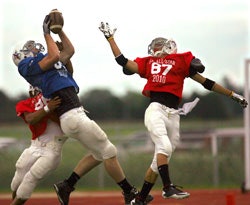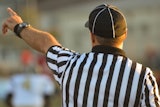Nathan Stiles, a senior football player at Spring Hill (Kan.) High School, was playing an epic game against Osawatomie High on a Thursday night last October. He already had 65- and 18-yard touchdown runs when he came out of the game after being tackled near the sideline just before halftime.
 TEST SCORE Casey Nordine (in blue) of Rapid City Stevens pulls down a touchdown pass at the South Dakota All-Star game. Stevens is one of several schools in the state that implemented the ImPACT computer-based baseline testing program this season.
TEST SCORE Casey Nordine (in blue) of Rapid City Stevens pulls down a touchdown pass at the South Dakota All-Star game. Stevens is one of several schools in the state that implemented the ImPACT computer-based baseline testing program this season.Nathan Stiles, a senior football player at Spring Hill (Kan.) High School, was playing an epic game against Osawatomie High on a Thursday night last October. He already had 65- and 18-yard touchdown runs when he came out of the game after being tackled near the sideline just before halftime. Stiles walked over to the bench, complaining of severe head pain. He sat down, stood up, then collapsed. The star football player and homecoming king was pronounced dead later that evening. While the exact cause of Stiles' death has not been released, his father said Nathan suffered a concussion in the school's homecoming game earlier that month. He also said his son had been cleared to play in the Thursday game.
Stiles' tragic death is just one of many recent stories of brain-related fatalities among young athletes, who are particularly susceptible to Second Impact Syndrome (SIS), a potentially fatal condition where the brain suddenly swells after the athlete has suffered head trauma. While SIS-related death only occurs an average of 34 times per year, according to Dr. Mark Lovell, director of the University of Pittsburgh Medical Center Sports Medicine Concussion program, the more common residual effects include head trauma such as headaches, dizziness, confusion and long-term disabilities. "What we see all the time, unfortunately, is kids who return to play and end up with more severe difficulties with school and focusing their attention," Lovell says.
The Kansas State High School Activities Association is one of many such groups with policies that recommend that players who show signs of concussion should be benched and not return until they are cleared by a healthcare professional. In fact, some states even have laws that require as much. However, Rick Bowden, the association's executive director, says that in many cases coaches might be the ones deciding when a player is allowed to return by comparing the cognitive abilities of an athlete before and after a head injury, without the benefit of a full range of baseline testing. But as awareness increases about concussion risks, many high schools are now taking a more proactive approach to baseline testing and injury management, making the decision to put a player back in the game less subjective. In addition to symptom checklists and cognitive and physical field tests, new tools and methods are being developed to make such testing easy to administer.
One of the tools gaining popularity among high schools is ImPACT (Immediate Post-Concussion Assessment and Cognitive Testing) computer-based screening. Lovell and neurosurgeon Joseph Maroon developed the test in the early 1990s while working with the Pittsburgh Steelers. "I got involved with the Steelers about 20 years ago, and quickly realized that there was nothing in place in sports with regard to making these difficult decisions about when somebody could actually return after being injured," Lovell says.
While traditional neuropsychological field tests rely on a doctor, trainer or even a coach to make a judgment call, the ImPACT test compares before- and after-injury data from a series of brief cognitive tests to determine if an athlete is ready to return. Before the season starts, each player takes the 25-minute test measuring various aspects of memory, and that score is used as a baseline comparison. The idea is that the brain is run through a series of cognitive tests that are more difficult if the test-taker is impaired. "Think of it as a stress test for the brain," Lovell says.
The advantages of a computerized test are that it is completely randomized, it can be administered almost anywhere and the results are instant. Because the learning curve is relatively low, it allows those outside the medical community, such as trainers and coaches, to use the test effectively.
According to ImPACT administrators, there are more than 2,300 high schools in the United States and Canada using the system. Rapid City, S.D., is one school district that introduced the ImPACT program this fall, and Paul Richter, an athletic trainer with the local Black Hills Orthopedic and Spine Center, can already see the positive effects. Richter works with several area high schools, and he says he found that the test has led to a more conservative approach among sideline personnel than in years past. "It's an easy system to run, and so I think it just brings heightened awareness to head injuries," Richter says.
The test was introduced into the district's high school football, soccer and volleyball programs, and the district plans to use it for its other contact or collision sports such as gymnastics, basketball, wresting and pole vaulting.
"If I see anybody who shows signs or symptoms of a concussion, we pull them from the game, and then they are done for that day," Richter says. Lovell says that part of ImPACT is training people how to do a complete concussion assessment. "If you identify that the athlete has a head injury, the single most important thing that you can do is get them off the field," he says. The injured player then needs to have a physician's clearance and a passing ImPACT test score to be allowed back. Depending on the severity of the injury, the process of attaining a passing baseline score could take a couple of days, or several weeks. In the end, the physician has the final say. Says Richter, "It's not the clear-cut test whether an athlete returns to play or not, but it's another tool that I can use and physicians can use to determine if the brain itself is functioning properly."
Lovell stresses the need to have the student-athlete get in a hard workout before the decision is made to return to play. "As you elevate your heart rate, the concussion symptoms tend to come back," he says.
As concussion awareness is on the rise, Richter feels further educating parents, players, coaches, administrators and even the medical community has been the biggest factor in successfully introducing ImPACT into his school's athletic program. The district's athletic trainers collaborated to make sure the baseline tests were administered uniformly and according to the program's specifications. The trainers held an informational meeting so players and parents knew exactly what to expect before the baseline tests. "A lot of kids thought it was an IQ test and kind of a pass-fail deal," Richter explains. Trainers and doctors in the program also met with physicians at a local hospital to help create a standard protocol for concussion treatment. "It's not that we don't have everyone on board that concussions are serious, but we're trying to get concussion treatment more standardized in the community," Richter says.
Another key to successfully bringing ImPACT to Rapid City was getting donations from area doctors and businesses to cover the approximately $500-per-school cost of the tests. Smaller schools with lower budgets can get the test for less because the cost is based on class size. Richter would like to see the reach of the tests expanded to the area's smaller outlying schools and hopes other local businesses and booster clubs will step in to help defray the cost. "I think every school could probably find a couple hundred extra dollars to do this," he says.




































